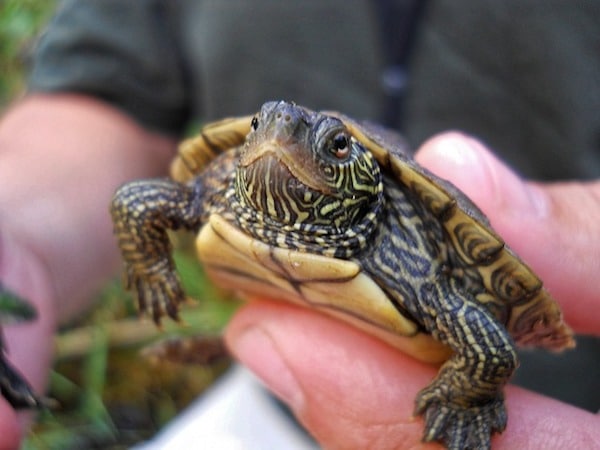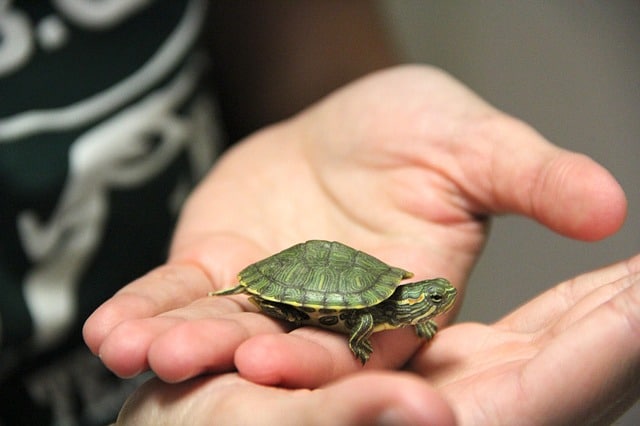Whether you’re looking to choose a turtle for an indoor aquarium or an outdoor pond, pet turtles are cute, fascinating to watch, and, when properly cared for, can provide gentle companionship for dozens of years. However, keeping turtles can be more difficult than many people expect, so beginner turtle keepers will need to learn about several of the best pet turtles in order to pick the one that fits their space and set up perfectly.
Red-Eared Sliders

Red-eared sliders, also sometimes called Cumberland sliders, are perhaps the most popular pet turtle. These attractive amphibians are beautifully colored, tend to be even-tempered, and are readily available, which is why they are one of the best pet turtles.
In the Wild
Red-eared sliders occupy a wide habitat in the United States and can be found in streams, ponds, and lakes across most of the states. Red-eared sliders enjoy slow-moving, warm water, and they are excellent swimmers.
Ideal Habitat
Because they love to swim so much, red-eared sliders will spend a large amount of time in the water. They can also grow to about a foot in length. Therefore, they should be given plenty of space, with a large area of water. Generally, it’s recommended that one gallon of water is provided for every inch of the turtle’s shell. An ideal enclosure for a fully grown red-eared slider is about 120 gallons.
Red-eared sliders will also need a basking dock so they can occasionally leave the water, as well as a basking light to simulate sunlight and ensure they’re getting the UVA and UVB light. All turtles need these types of light in order to stay healthy.
You’ll also want to add two thermometers to your habitat. One should be placed near the basking area, and the temperature there should be between 85 and 90 degrees Fahrenheit. The other should be in the water, which should remain between 75 and 85 degrees Fahrenheit. An aquarium heater can help you maintain this temperature.
Basic Care
When provided with the correct amount of space, these omnivorous turtles are relatively easy to care for. They can be given commercial turtle food, although this can occasionally be supplemented with insects such as crickets or superworms, or fruits and vegetables such as strawberries, leafy greens, or cantaloupe.
Adult red-eared sliders should be given small meals every two or three days. Younger turtles can be fed every day. Red-eared sliders can be messy, so it’s important to include a powerful filtration system in your setup and also perform frequent partial water changes. This feeding and cleaning schedule applies to most common turtle species.
Temperament
Most turtles are pets to be observed, not touched, and prefer not to be handled. However, red-eared sliders are often friendlier than other turtle species and don’t seem to mind when they are occasionally gently picked up.
Lifespan
Red-eared sliders can live for between 20 and 40 years.
Painted Turtles
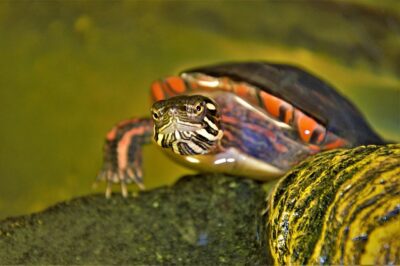
Often considered one of the best pet turtles because of their slightly smaller size and ease of care, painted turtles are readily available in the pet trade. In addition, their dark shells and colorful leg and head markings, as well as their docile temperaments, make them both an attractive and logical choice for beginners.
In the Wild
Like red-eared sliders, painted turtles are found across the United States and Canada. These turtles prefer shallow, slow-moving water with plenty of vegetation and muddy bottoms, and they are often found in marshes, creeks, or ponds.
Ideal Habitat
Painted turtles grow to between four and 10 inches in length. As with many turtle species, males are slightly smaller. Adult painted turtles will need an aquarium of 100 gallons or more, most of which should be water, as these turtles spend the majority of their time swimming.
Painted turtles will also need a basking area, either in the form of a pre-made dock or rocks piled securely to create a dry area, over which a basking light can be hung. The temperature in the basking area should be between 85 and 95 degrees Fahrenheit, while the water temperature should be between 75 and 80 degrees.
Basic Care
Painted turtles are omnivorous and, like most turtles, eat while they’re swimming. You can float commercial pellets in the water, but, as with the red-eared slider, it’s also important to ensure that about half of their diet is made up of leafy greens. Fruits and other vegetables, as well as insects or freeze-dried shrimp, can also be given occasionally.
Temperament
Painted turtles are relatively calm, and they don’t mind being handled as much as many other turtle species. However, they should still be picked up only when necessary.
Lifespan
Painted turtles generally live for between 20 and 30 years but can live for up to 50 years.
Mud Turtles
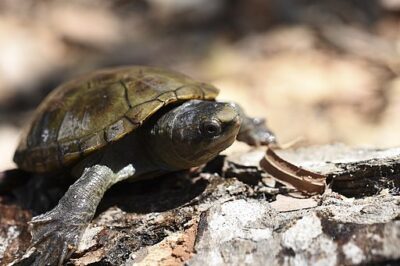
There are several different mud turtle varieties that are known as good options for the best pet turtles, including the Mississippi mud turtle, yellow mud turtle, and the eastern mud turtle. These smaller turtles, which only grow to between three and six inches, are often a good option for people who only have room for more compact tanks.
In the Wild
Mud turtles, as their name suggest, will sometimes bury themselves in mud if the water level in the shallow ponds they favor drops too far. In the United States, they’re common in the south, but some varieties can be found as far north as New England, and their range extends into South America.
Ideal Habitat
The mud turtle’s aquarium will need to be about 50 or 60 gallons in size, at least. Mud turtles bask very little, but a basking platform made of carefully piled rocks or driftwood should be added regardless. Covering the area in sand can also provide a more natural look and feel.
The turtle’s water should maintain a temperature around or just over 70 degrees Fahrenheit. The basking area temperature should be around 90 degrees.
Basic Care
Like many turtles, mud turtles are omnivorous, but these particular turtles tend to favor meaty foods. Commercial turtle foods provide well-rounded nutrition, but foods such as earthworms, crickets, shrimp, and leafy greens can also be offered.
Temperament
Mud turtles generally do not enjoy being handled and may attempt to bite when they are picked up.
Lifespan
Mud turtles generally live for about 30 years but can live to be 50 with the right care.
Razorback Musk Turtles
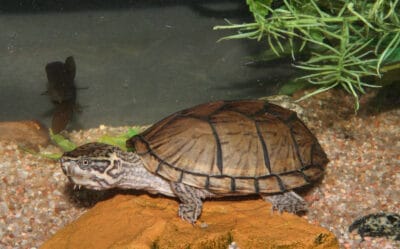
Several types of musk turtles make excellent pets, but the razorback musk turtle is the most popular. These turtles are light tan in color and their shells, as their name suggests, feature a ridge along the top.
In the Wild
Razorback Musk turtles spend most of their lives in the water and favor slow-moving water with dense vegetation. They can be found in Arkansas, Florida, Louisiana, Mississippi, Oklahoma, and Texas.
Ideal Habitat
Razorback musk turtles grow to between five and eight inches in length, so they’ll require an aquarium of between 20 and 30 gallons. Although they almost never bask, you should still provide a small basking area, such as secured driftwood, for them to climb onto.
The temperature in the basking area should be between 82 and 90 degrees Fahrenheit, while the water temperature should be between 74 and 79 degrees.
Basic Care
Razorback musk turtles are mostly carnivorous and will eat commercial pellets, frozen turtle food, crickets, and bloodworms. They can also be offered duckweed. Offering live foods can often encourage these sometimes picky turtles to eat.
Temperament
Razorback musk turtles get their name from the smell they emit when they feel threatened, which can be quite unpleasant. Pick them up only when necessary to avoid stressing them, and always handle them at the rear of the shell so as to avoid bites.
Lifespan
Razorback musk turtles live for about 20 years.
Eastern Box Turtles

Eastern box turtles are some of the most vibrantly colored pet turtles, with red and yellow markings across their heads, legs, and shells. They’re also known to be relatively friendly, making them a good choice for beginner turtle enthusiasts.
In the Wild
The eastern box turtle, a subspecies of the common box turtle, is mostly found along the eastern edge of the United States, but its territory extends as far west as Texas. Unlike most of the turtles on this list, box turtles prefer to spend their time on land and can be found roaming around grasslands, damp meadows, or the edges of wooded areas.
Ideal Habitat
Adult eastern box turtles, which can grow to six inches in length, will need a terrarium that’s four feet by four feet. The turtle should also have access to water, which can be provided in the form of a large but shallow pan or dish. The water should be about three inches deep for adult turtles, and the turtles should be able to climb in and out with ease.
A substrate that retains moisture and provides humidity, such as a safe reptile substrate, should be added to the bottom of the tank. Logs, real or artificial plants, or other pre-made decorations should also be placed in the terrarium in order to provide a natural look and plenty of hiding places.
The turtles will also require a basking light at one end of the terrarium. The temperature in the basking area should be between 85 and 90 degrees Fahrenheit and should be between 75 and 85 degrees in the rest of the terrarium. The humidity should be between 70 and 80 percent.
Basic Care
Eastern box turtles are omnivorous and can be fed crickets, hornworms, leafy greens, vegetables such as squash and zucchini, and fruits such as strawberries and bananas.
Temperament
Eastern box turtles will come out from hiding and explore once they feel safe in their environment, and this can make them fascinating to observe. However, even the friendliest of these turtles do not appreciate being handled any more than necessary.
Lifespan
Eastern box turtles can live for between 80 and 100 years, so be sure you’re ready for a lifetime pet before committing to this turtle species.
False Map Turtles
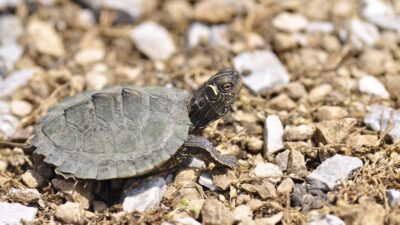
False map turtles, which can grow to between six and ten inches in length, have beautiful, pointed shells, delicate yellow patterning, and are relatively easy to care for.
In the Wild
False map turtles can be found mostly in Ohio, Indiana, Missouri, Illinois, Nebraska, Kentucky, Minnesota, and North and South Dakota. They are largely aquatic and enjoy water with a steady flow.
Ideal Habitat
Adult false map turtles can grow to be quite large, so an aquarium of 75 gallons or more will be necessary. A basking platform and light should be installed. False map turtles will also appreciate an underwater resting area such as a rock or piece of driftwood. Plants can also provide hiding places. As with most aquatic turtles, the bottom of the aquarium can be left bare.
The temperature of the water in the habitat should be around 75 degrees Fahrenheit, while the basking area should be between 85 and 90 degrees.
Basic Care
False map turtles are omnivorous and can be fed a staple diet of turtle pellets, supplemented with duckweed, crickets, trout chow, and bloodworms. Calcium should also be provided.
Temperament
False map turtles rarely bite and tend to be calmer and friendlier than other turtle species, which makes them one of the best pet turtles. However, they can also be timid, so it’s important to let them adjust and warm up to you before handling them too much.
Lifespan
False map turtles can live for between 20 and 50 years.
Because of the aquarium space they require and their long lifespans, turtles are a pet that should only be chosen by those who are committed to their care. However, once the perfect beginner turtle is selected, and the proper care is provided, you will have a beautiful, entertaining, and interesting companion for many years to come.



